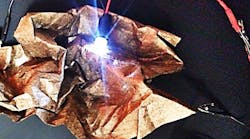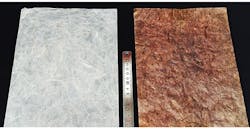Using a simple layer-by-layer coating technique, researchers from the U.S. and Korea have developed a paper-based flexible supercapacitor that could be used to power wearable devices. The device uses cellulose fibers in the paper coated with metallic nanoparticles, creating supercapacitor electrodes with high energy and power densities—and the best performance so far in a textile-based supercapacitor. They even work when crumpled (see top image).
Implanting conductive and charge-storage materials in the paper creates large surface areas that act as current collectors and nanoparticle reservoirs for the electrodes. Tests show that capacitors fabricated with this material can be folded thousands of times without affecting conductivity.
“This type of flexible energy-storage device could provide unique opportunities for connectivity among wearable and IoT devices,” says Seung Woo Lee, an assistant professor in the Woodruff School of Mechanical Engineering at the Georgia Institute of Technology. “We could support an evolution of the most advanced portable electronics. We also have an opportunity to combine this supercapacitor with energy-harvesting devices that could power biomedical sensors, consumer and military electronics, and similar applications.”
Energy storage devices are generally judged on three properties: energy density, power density, and cycling stability. Supercapacitors typically have high power density, but low energy density (the amount of energy that can be stored) compared to batteries, which often have the opposite attributes. In developing their new technique, the researchers set out to boost supercapacitors’ energy density, all the while maintaining their high power outputs.
They began by dipping paper samples into a beaker of an amine surfactant designed to bind gold nanoparticles to the paper. Next they dipped the paper into a solution containing gold nanoparticles. The fibers are porous, so the surfactant and nanoparticles go into the fibers and become strongly attached, creating a conformal coating on each fiber.
By repeating the dipping steps, researchers created a conductive paper on which they added alternating layers of metal oxide energy-storage materials such as manganese oxide. The layer-by-layer approach helped minimize contact resistance between neighboring metal and/or metal oxide nanoparticles. The dipping process is done at room temperatures and builds up layers to provide the desired electrical properties.
Though the research involved small samples of paper, the technique could likely be scaled up using larger tanks, or even a spray-on approach. “There should be no limitation on the size of the samples we produce,” Lee says. “We just need to establish the optimal layer thickness that provides good conductivity while minimizing the use of the nanoparticles for the best tradeoff between cost and performance.”
The research team demonstrated that their technique improves several aspects of paper supercapacitors. The maximum power and energy density of the metallic paper-based supercapacitors are estimated to be 15.1 mW/cm2 and 267.3 uW/cm2, respectively, substantially outperforming conventional paper and textile supercapacitors.
The next steps will include testing the technique on flexible fabrics and developing flexible batteries that could work with the supercapacitors. The researchers initially gold nanoparticles because they are easy to work with, but plan to test less expensive metals such as silver and copper to reduce costs.


